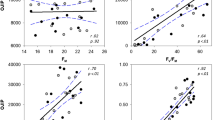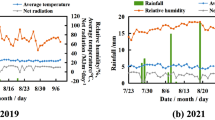Abstract
Background and aim
Phosphorus (P) is an essential macronutrient with major impacts on global crop productivity. Recent work showed that chlorophyll a fluorescence analysis can be used as a sensitive indicator of latent P deficiency across different plant species. Here, we demonstrate that chlorophyll a fluorescence OJIP transients are a powerful tool for early detection of P deficiency directly in the field.
Methods
Barley was grown in a P responsive field. One treatment received 30 kg P ha−1 at sowing, four treatments were fertilized with P at 26, 35, 46 or 56 days after sowing (DAS), respectively, and the final treatment did not receive any P throughout the experiment. Chlorophyll a fluorescence measurements, multi-elemental leaf analysis, and growth stage evaluation were performed 26, 35, 46, 56, and 69 DAS.
Results
Phosphorus deficiency during early vegetative growth irreversibly affected plant development including tiller outgrowth and grain yields. However, in the present study, yield reduction could be avoided if short-term P deficiency was corrected by application of P fertilizer no later than 35 days after sowing, when plants had not yet entered the tillering stage. The chlorophyll a fluorescence OJIP transients were able to detect latent P deficiency in this critical phase, thereby providing an opportunity for avoiding a potential yield reduction of up to 27 hkg ha−1. It was further noted, that chlorophyll a fluorescence analysis and P leaf tissue analysis should be performed during early vegetative growth, as probable remobilization of P within the plant during tillering and shoot differentiation masks the effects of P deficiency at the single leaf level.
Conclusions
It is concluded that chlorophyll a fluorescence analysis provides a unique opportunity for a timely detection and correction of P deficiency under field conditions to prevent yield reductions.





Similar content being viewed by others
References
Alqudah AM, Koppolu R, Wolde GM et al (2016) The genetic architecture of barley plant stature. Front Genet 7:1–15
Arisnabarreta S, Miralles DJ (2008) Critical period for grain number establishment of near isogenic lines of two- and six-rowed barley. Field Crops Res 107:196–202
Baker A, Ceasar SA, Palmer AJ et al (2015) Replace, reuse, recycle: improving the sustainable use of phosphorus by plants. J Exp Bot 66:3523–3540
Barker M, Rayens W (2003) Partial least squares for discrimination. J Chemom 17:166–173
Brenchley WE (1929) The phosphate requirement of barley at different periods of growth. Ann Bot 43:89–108
Brereton RG, Lloyd GR (2014) Partial least squares discriminant analysis: taking the magic away. J Chemom 28:213–225
Brestic M, Zivcak M (2013) PSII fluorescence techniques for measurement of drought and high temperature stress signal in crop plants: protocols and applications. In: Rout GR, Das AB (eds) Molecular stress physiology of plants. Springer, Bhubaneswar, pp 1–20
Carstensen A, Herdean A, Schmidt SB et al (2018) The impacts of phosphorus deficiency on the photosynthetic electron transport chain. Plant Physiol 177:271–284
Cordell D, White S (2015) Tracking phosphorus security: indicators of phosphorus vulnerability in the global food system. Food Sec 7:337–350
Cordell D, Drangert JO, White S (2009) The story of phosphorus: global food security and food for thought. Glob Environ Chang 19:292–305
del Moral MBG, del Moral LFG (1995) Tiller production and survival in relation to grain yield in winter and spring barley. Field Crops Res 44:85–93
Edixhoven JD, Gupta J, Savenije HHG (2013) Recent revisions of phosphate rock reserves and resources: reassuring or misleading? An in-depth literature review of global estimates of phosphate rock reserves and resources. Earth Syst Dynam 4:1005–1034
Elliott D, Reuter D, Reddy G, Abbott R (1997) Phosphorus nutrition of spring wheat (Triticum aestivum L.) 1. Effects of phosphorus supply on plant symptoms, yield, components of yield,and plant phophorus uptake. Aust J Agric Res 48:855–867
Evers JB, Vos J (2013) Modeling branching in cereals. Front Plant Sci 4:1–6
Frydenvang J, van Maarschalkerweerd M, Carstensen A et al (2015) Sensitive detection of phosphorus deficiency in plants using chlorophyll a fluorescence. Plant Physiol 169:353–361
Gilbert N (2009) The disappearing nutrient. Nature 461:716–718
Goltsev VN, Kalaji HM, Paunov M et al (2016) Variable chlorophyll fluorescence and its use for assessing physiological condition of plant photosynthetic apparatus. Russ J Plant Physiol 63:869–893
Grant CA, Flaten DN, Tomasiewicz DJ, Sheppard SC (2001) The importance of early season phosphorus nutrition. Can J Plant Sci 81:211–224
Green DG, Ferguson WS, Warder FG (1973) Accumulation of toxic levels of phosphorus in the leaves of phosphorus-deficient barley. Can J Plant Sci 53:241–246
Guo Y, Tan J (2015) Recent advances in the application of chlorophyll a fluorescence from photosystem II. Photochem Photobiol 91:1–14
Hammond JP, White PJ (2008) Sucrose transport in the phloem: integrating root responses to phosphorus starvation. J Exp Bot 59:93–109
Hansen TH, Laursen KH, Persson DP et al (2009) Micro-scaled high-throughput digestion of plant tissue samples for multi-elemental analysis. Plant Methods 5:1–11
Hawkesford M, Horst W, Kichey T, et al (2011) Functions of macronutrients. In: Marschner P (ed) Marschner’s mineral nutrition of higher plants: Third Edition, Third. Elsevier Ltd, pp 135–189
Hoppo SD, Elliott DE, Reuter DJ (1999) Plant tests for diagnosing phosphorus deficiency in barley (Hordeum vulgare L.). Aust J Exp Agric 39:857–872
Hotelling H (1931) The generalization of Student’s ratio. Ann Math Stat 2:360–378
Hussien A, Tavakol E, Horner DS et al (2014) Genetics of Tillering in Rice and barley. Plant Genome 7:1–20
Jones E, Oliphant E, Peterson P (2001) SciPy: open source scientific tools for Python
Kalaji HM, Goltsev VN, Zuk-Golaszewska K et al (2017) Chlorophyll fluorescence understanding crop performance - basics and applications. CRC Press, Taylor & Francis Group, Boca Raton
Kebrom TH, Spielmeyer W, Finnegan EJ (2013) Grasses provide new insights into regulation of shoot branching. Trends Plant Sci 18:41–48
Kirby EJM, Jones HG (1977) The relations between the main shoot and tillers in barley plants. J Agric Sci 88:381
Kirby EJM, Appleyard M, Fellowes G (1985) Leaf emergence and tillering in barley and wheat. Agronomie 5:193–200
Knudsen L, Østergaard HS (2012) Tolkning af jordbundsanalyser. Planteavlsorientering 07-483. Report from SEGES, Agro Food Park 15, 8200 Aarhus N, Denmark
Lauer J, Simmons S (1988) Photoassimilate partitioning by tillers and individual tiller leaves in field-grown spring barley. Crop Sci 28:279–282
MacDonald GK, Bennett EM, Potter PA, Ramankutty N (2011) Agronomic phosphorus imbalances across the world’s croplands. Proc Natl Acad Sci U S A 108:3086–3091
Mason S, McNeill A, McLaughlin MJ, Zhang H (2010) Prediction of wheat response to an application of phosphorus under field conditions using diffusive gradients in thin-films (DGT) and extraction methods. Plant Soil 337:243–258
McKinney W (2010) Data structures for statistical computing in python. In: Proceedings of the 9th Python in Science Conference. pp 51–56
Mundus S, Carstensen A, Husted S (2017) Predicting phosphorus availability to spring barley (Hordeum vulgare) in agricultural soils of Scandinavia. Field Crops Res 212:1–10
Reuter DJ, Robinson JB (1997) Plant analysis: an interpretation manual, 2nd edn. CSIRO publishing, Collingwood
Rodríguez D, Pomar MC, Goudriaan J (1998) Leaf pimordia initiation, leaf emergence and tillering in wheat (Triticum aestivum L.) grown under low phosphorus condition. Plant Soil 202:149–157
Rodríguez D, Andrade FH, Goudriaan J (1999) Effects of phosphorus nutrition on tiller emergence in wheat. Plant Soil 209:283–295
Rychter AM, Rao IM (2005) Role of phosphorus in photosynthetic carbon metabolism. In: Pessarakli M (ed) Handbook of photosynthesis, 2nd edn. CRC Press, Florida, pp 123–148
Simmons SR, Rasmusson DC, Wiersma JV (1982) Tillering in barley - genotype, row spacing, and seeding rate effects. Crop Sci 22:801–805
Sørensen NK, Bülow-Olsen A (1994) Fælles arbejdsmetoder for jordbundsanalyser. Landbrugsministeriet, Plantedirektoratet, Lyngby
Strasser JR, Srivastava A, Tsimilli-Michael M (2000) The fluorescence transient as a tool to characterize and screen photosynthetic samples. In: Yunus M, Pathre U, Mohanty P (eds) Probing photosynthesis: mechanism. Regulation & Adaptation. CRC Press, Florida, pp 445–483
Ticconi CA, Abel S (2004) Short on phosphate: plant surveillance and countermeasures. Trends Plant Sci 9:548–555
White PJ, Veneklaas EJ (2012) Nature and nurture: the importance of seed phosphorus content. Plant Soil 357:1–8
Zadoks J, Chang T, Konzak C (1974) A decimal code for the growth stages of cereals. Weed Res 14:415–421
Acknowledgements
This work was funded by University of Copenhagen and Innovation Fund Denmark (Future Cropping). We are especially grateful to Leif Knudsen (SEGES) for assistance with identifying P responsive soils, Jens Lyhne Kristiansen (LandboNord) for preparing the experimental field and finally Frede Jacobsen for making his field available to us. This work was supported by the University of Copenhagen and Innovation Fund Denmark (Future Cropping).
Author information
Authors and Affiliations
Corresponding author
Ethics declarations
Conflict of interest
A.C., J.F., and S.H. are co-applicants on the patent (PCT/EP2013/069899) describing the use of chlorophyll a fluorescence to determine the nutritional status of plants, and are founders of the university spin-out SpectraCrop IVS, marketing a hand-held device for predicting the P status of plants. For this reason, there may be a conflict of interest in order to show that the developed P model is able to predict the P status of barley leaves under field conditions. It should be noted that similar OJIP transients, as the ones recorded in this study, can be obtained by a broad range of standard chlorophyll a fluorescence instruments, including Photon Systems Instruments (PSI), Walz, Hansatech, Opti Sciences, Phenospex and MultispeQ.
Additional information
Responsible Editor: Philip John White
Electronic supplementary material
ESM 1
(DOCX 8750 kb)
Rights and permissions
About this article
Cite this article
Carstensen, A., Szameitat, A.E., Frydenvang, J. et al. Chlorophyll a fluorescence analysis can detect phosphorus deficiency under field conditions and is an effective tool to prevent grain yield reductions in spring barley (Hordeum vulgare L.). Plant Soil 434, 79–91 (2019). https://doi.org/10.1007/s11104-018-3783-6
Received:
Accepted:
Published:
Issue Date:
DOI: https://doi.org/10.1007/s11104-018-3783-6




